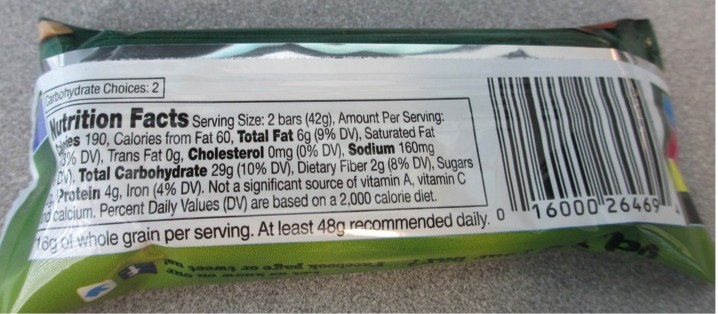I’m going to embarrass my husband. Recently he remarked that he just doesn’t get why Nature’s Valley granola bars are so high in calories. At close to 400 of them a package, why not have a candy bar?
Not the greatest image, but can you tell what he was doing wrong?
 The info listed on the label is for two bars, not for one as he assumed. He doubled the calories because he finished the package. Not necessary.
The info listed on the label is for two bars, not for one as he assumed. He doubled the calories because he finished the package. Not necessary.
Okay. I’ve always known that nutrition labels are tricky. But if someone who is incredibly smart, good with numbers and married to a dietitian still doesn’t get it, we’ve got a problem. Even my clients who claim to be 100% confident in their label reading skills are typically missing one or two important points. For the average consumer – and by that I mean anyone without an RD, MS or PhD in nutrition next to his name – labels stink.
First, there is the serving size issue. Sometimes, what looks like a single serving food item actual contains two or more servings according to the nutrition label. Then there is the matter of deciding what we should even care about. How many calories are “too many”? Should we be concerned about total fat? Total carbohydrates? Sugar? It’s no surprise that most of us just ignore the label altogether.
But my plea to you is this: Don’t. While most of the healthiest foods – fruits and vegetables as well as nuts, grains and beans from bulk bins – don’t have nutrition labels to begin with, it’s inevitable that at least a few packaged foods end up in most of our grocery carts. Nutrition labels allow us to make informed decisions about whether that food is worthy of our bellies. Unlike most of the meaningless front of label packaging (All Natural!, Made with Whole Grain!, etc.), nutrition labels give us the power to see through the BS. They are especially useful in helping us decide between similar products.
So in my next two posts, which I’ll share over the remainder of the workweek, I’ll discuss the nuts and bolts of nutrition label reading including extra detail for those who are interested, and provide a chart showing what you should pay attention to within particular classes of food. For example, saturated/trans fat and sodium are important to consider when comparing snack foods like crackers, pretzels, etc., while fiber and sugar content should be more of a focus when comparing cereals.
Until then, do a little prep work by taking a look at food labels on your daily breakfast cereal, favorite office snack, etc. Share what kind of label your looking at in the “Leave a Reply” section below and what information you use on the label to decipher its health value. I’ll provide feedback and perhaps your label will be featured in one of the two remaining nutrition panel posts.